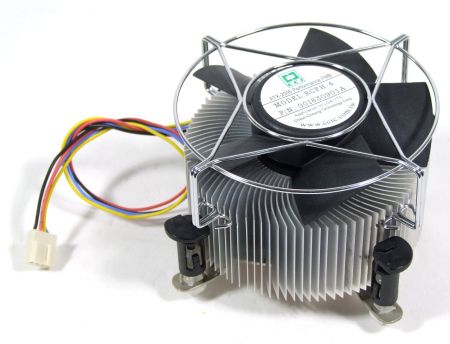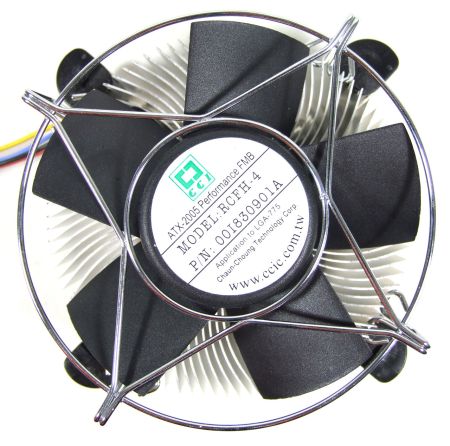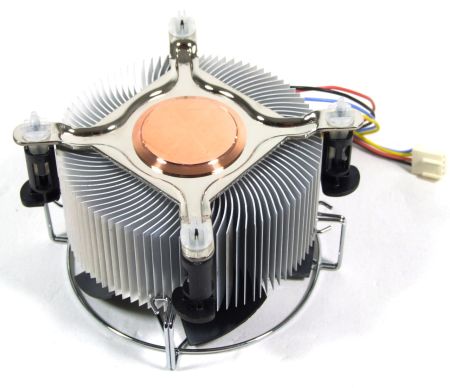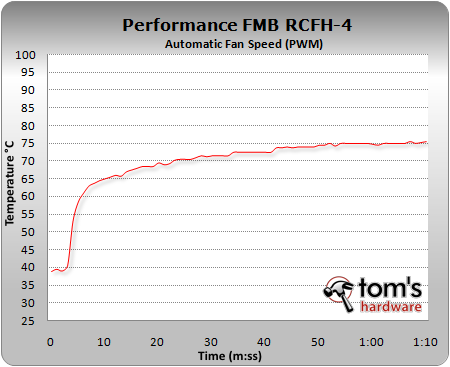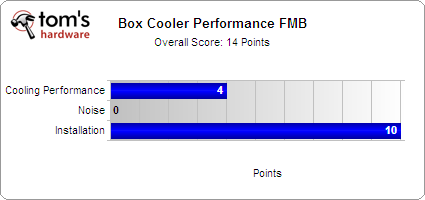CPU Cooler Charts 2008, Part 3 - Are Box Coolers any Good?
Performance FMB2 RCFH-4 - Loudest. Cooler. Ever
When Intel unveiled the dual-core processors of the Pentium D 80 series, the thermal power loss of its processors jumped dramatically again - suddenly there were two 90 nm CPU cores on a single socket that needed to be cooled. Intel's specifications stated a thermal design power of 130 W, pushing the coolers of the time to their limits, and sometimes even past them. In many cases, users were unable to benefit from the processors' full performance potential, because it had to throttle its clock speed (and thus its performance) to keep from overheating.
Loud - the Performance FMB
This development did not stop there, though, and Intel launched the Pentium Extreme Edition 840, running at 3.20 GHz. Intel's flagship CPU got even hotter than its siblings, which is unsurprising considering that it, too, was a dual-core part. It also sported Hyper-Threading technology, for a total of four virtual cores.
Performance FMB2
In order to adequately cool this CPU, Intel began bundling its press samples with the famous, or rather infamous, "Performance FMB". This was the first version of the box cooler to feature cooling fins pointing in the opposite direction of the fan. It also sported a small protective grid above the fan.
Hearing this fan in operation is anything but an enjoyable experience. Running at 61 dB(A), it can easily be made out even from a few rooms away. Cooling performance is also not really in line with today's requirements. Even when spinning its fan at full blast, which translates to almost 5000 RPM, the Performance FMB can only cool the CPU to 76°C.
A copper core is inset into the Performance FMB.
Get Tom's Hardware's best news and in-depth reviews, straight to your inbox.
| Technical Data | ||
|---|---|---|
| CPU | 100% load | idle |
| Temperature PWM | 76.5°C | 40.5°C |
| Noise | 61.1 dB(A) | 43.9 dB(A) |
| Fan speed | 4900 RPM | 2300 RPM |
| Weight | 534 grams | Row 4 - Cell 2 |
| Intel socket | 775 | Row 5 - Cell 2 |
Current page: Performance FMB2 RCFH-4 - Loudest. Cooler. Ever
Prev Page Prescott FMB2 C40387 - The Prescott's First Cooler Next Page XP01 S2683 - Bigger Copper Core And Greater Contact Pressure-
Hugger I have read the 3 part article on cpu coolers a few times.Reply
In each part, the author shows the names of all the coolers that are included in the tests.
Xigmatech is one of those names.
However, I can't find test results for that cooler.
I'm ordering parts and have read good things about the Xigmatech but wanted to read the review here too.
Am I missing it or has it been left out?
Thanks.
Hugger -
bbies1973 In other forums I have seen the dispute about the best air cooler being between three models that were not tested in here. Dissapointing because two of the manufacturer's submitted coolers for this test. The three are:Reply
Zalman 9700 (8700 was tested here)
ThermalTake CL-P0401 V1 (Thermaltake was listed but I didn't see any of their products in the article)
Third, Tuniq Tower 120. (Tuniq is a subsidiary of Sunbeam, and neither are listed as represented companies for the test.
I would love to see a part 4 coming with these three pieces represented. -
Sigh. I looked at this list and then looked at the lists on frostytech, and none of the products coincide... how convenient.Reply
-
ripusheet01 how a fanless cpu cooler be noisy? how can be sound of a fanless heatsink be measured?Reply -
dragunover This article is Bull,it doesn't list the common coolers,and he obviously used crap thermal grease.Arctic Silver 5 and a Xigmatek/Scythe/Tuniq anyone?Reply -
gto127 It's strange that thermalright isn't mentioned here. They've been consistantly at the top of the cooling game for years and are included in most site cool off tests and come up on top quite frequently. Please include in future tests.Reply -
Twist86 Seems like none of the best coolers are mentioned here. Just ones that are over priced/out performed by cheaper coolers.Reply
Zalman 9700
Xigmatek S1283
Tuniq Tower 120
This review fails.
